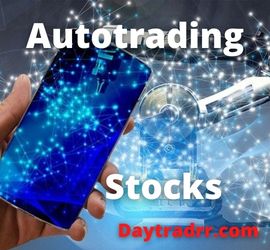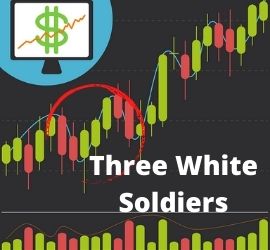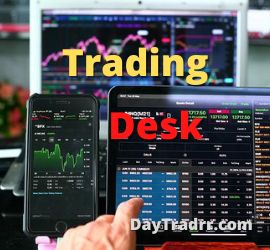What Is Autotrading?
 Autotrading stocks and financial instruments is a method of entering and exiting trades using a program or platform that executes trading algorithms with pre-set rules.
Autotrading stocks and financial instruments is a method of entering and exiting trades using a program or platform that executes trading algorithms with pre-set rules.
Autotrading is a pre-set trading plan where buy and sell orders are automatically placed based on an underlying algorithm or program. These orders are automatically placed when the trade conditions in the underlying system or program are met.
Automated trading allows investors to participate in financial markets utilizing pre-programmed rules to enter and exit deals. As the trader, you can customize these rules by combining your personal, in-depth technical analysis with positional instructions. For example, when to open orders, trailing stops, and guaranteed stops. Auto trading allows traders to execute multiple trades in a short period of time. It also removes emotion from trading decisions. This is due to the fact that all of the rules of the trade are already embedded into the pre-specified parameters. As Artificial Intelligence (AI) improves, there are even pre-determined algorithms to follow trends and trade accordingly.
Autotrading Basics
Autotrading enables investors to profit from market opportunities in real-time. Complex programming and, in some circumstances, sophisticated trading systems permit external programming to determine trading parameters. Traders can create their own applications based on a personalized strategy. Or, they can connect to an existing program or platform to execute automated trades on their behalf. All categories of individual investors can use basic versions of autotrading. Setting orders that will execute in the future when specific criteria are met, for example, is the most basic type of autotrading.
On a higher level, autotrading completely eliminates human input. Once configured, the software will continue to run without human intervention or input. In the advanced situation, traders will continue to regularly check their programs to ensure that they are running as intended. Autotrading systems are utilized in a variety of markets, including stocks, cryptocurrencies, futures, options, and FX.
First, you will choose a platform and set the parameters of your trading strategy. You’ll use your trading experience to create a set of rules and conditions, and then your custom algorithm will apply the criteria to place trades on your behalf. These factors are normally based on the timing of the trade, the price at which it should be opened and closed, and the quantity. For example, ‘buy 100 Apple shares when its 50-day moving average goes above the 200-day average’. The automated trading strategy that’s been set will constantly monitor financial market prices, and trades will automatically be executed if predetermined parameters are met. The aim is to execute trades faster and more efficiently and to take advantage of specific, technical market events. (Source: ig.com)
Autotrading Capabilities
Autotrading requires using a predetermined trading strategy. The strategy then serves as the foundation for the computerized program. These initial parameters specify when and why it initiates trades. It can be constructed in a variety of ways to suit the needs of all types of investors. Basic autotrading systems can make investments at regular intervals or place conditional orders in equities or crypto that meet certain parameters. Conditional orders enable an investor to enter transactions at predetermined levels for automatic execution when a price is met.
Institutional investors and technical traders will use complex systems that allow for conditional orders and strategies such as grid trading, trend trading, scalping, or fading. Many technical day traders will only work with brokers that allow plug-ins or external programs to connect to their platform, or that offer a coding program within the platform itself to create indicators and autotrading programs. Brokerage platforms such as TD Ameritrade and Interactive Brokers, for example, offer coding and autotrading capabilities. Institutional investors will typically have their own proprietary trading platforms that allow for autotrading through algorithmic programming. (Source: investopedia.com)
Autotrading Strategies
Institutional investors often use complex algorithms that target trades for investment portfolios. Trades are initiated using defined criteria governed by a portfolio’s objective.
Mean Reversion
The mean reversion strategy is based on a straightforward assumption – if the price of a coin shifts from its average, then it’s eventually going to revert back to it. This assumption holds true both for traditional and cryptocurrency markets. The reason why this happens is because of the overall market psychology. Imagine we have a stock named “ABC” which has an average price of $10.
- If the price of ABC goes up to $12.50, other traders might sell off the asset to lock in a profit. Selling will drive the price downward, pushing it back to its original price of $10.
- Similarly, if the price drops to $8.50, the market may interpret this as a bottom. Buyers then start accumulating the “cheap” shares, eventually bringing the price back toward $10.
This technique is based on the concept that when an asset’s price deviates from its average, it will eventually return to its average. In many markets, this is a reasonable assumption to make. For example, if the price of XYZ falls to $50 from its lifetime average of $100, many traders may see the new price as low and buy in big quantities. This restores demand and pricing to their median levels. If the price rises to a new high of $150, traders may sell in bulk, lowering the market price. This approach is based on the simple idea of buy low, sell high. As a result, an algorithm that computes averages and executes transactions automatically can save time, money, and risk.
Momentum Trading
A momentum investor evaluates the market’s ebbs and flows based on its momentum. An ideal scenario would be to ride a bullish momentum wave, then sell off the assets as soon as the market momentum reverses. The underlying principle is the belief that an asset’s price will rise above its average before losing momentum and falling. The timing of the buy-in and sell-off is essential in this case.
Market volatility is often compared to a succession of waves in the ocean. The momentum investor keeps and holds short-term positions and sells at the height of the wave before it crashes. This technique assumes that prices will continue to increase above predicted averages before falling. However, entry timing (when a trader enters a market) and exit time (when a trader exits a market) are critical.
Arbitrage
The price of an asset can fluctuate across exchanges. This is primarily due to pricing fragmentation between marketplaces. For example, XYZ might be valued at $10.00 in Exchange A and $10.25 in Exchange B. You can earn from the Arbitrage approach by simultaneously buying and selling on exchanges. To take advantage of these price disparities, you must buy and sell practically simultaneously.
Crypto marketplaces can be fragmented and inefficient. As a result, cryptocurrency prices can vary significantly due to geography, time, jurisdiction, and laws. Arbitrage strategies work by purchasing and selling on exchanges at the same in order to profit from the spread. This method, unlike momentum trading, is unaffected by market performance and is relatively low-risk. However, it requires quick buying and selling. Transaction speed is critical to take advantage of price variations before they disappear. As a result, arbitrage is one of the most basic and effective tactics for programmed execution.
(Sources: blockgeeks.com & medium.com)
Autotrading Criteria
Autotrading may appear straightforward, but designing even a simple trading strategy is difficult. Rules must be basic enough to be coded and must not be subjective. A computer program requires clear rules. Consider the following, but do not limit yourself to them:
Program Parameters
- Size of trade — A trading position might be defined as a percentage of the total account. For example, equal to 20% of the account equity. Or it might be tied to optimal position sizing. This is defined as the gap between the entrance price and the stop loss, establishing a maximum risk, such as 2% of the account capital. Optimal position size is then determined based on the 2% risk and the distance between the stop loss and the entry on the specific transaction. The position size changes depending on the specifics of a trade. Therefore, this is an advanced position sizing strategy.
- Entering a trade — For example, for a trade to be entered on a moving average (MA), the price must first be on one side of the MA, then on the other. It is also necessary to provide the data source. What determines the price: the last price? what is the bid price? the asking price?
- Closing a trade – This can be done by putting limit and stop-loss orders at the start of the deal. These orders will close the deal at the order prices, regardless of whether the trade is profitable or not. A more complicated technique would be to set up a trailing stop loss.
- System limitations – These include things like when a programmer should or should not trade. The programmer, for example, may not want the software to execute until five minutes after the stock market opens. As a result, they would have to include a time constraint in the programming code.
- Safeguards – For example, if more than 5% equity is lost, or an open transaction loses more than a certain sum, the software terminates all deals and/or sends an email to an administrator to check on the program.
Autotrading Scams
Autotrading systems are relatively new. Unfortunately, they are under-regulated and frequently not subjected to formal review or independent testing.
- Programmed to match historical data – They can be shown to be successful on historical data. However, there is some evidence that many robots may have been over-optimized or designed to match the data.
- Scalping – When looking at robots with a high win rate, be wary of scalping — numerous trades for little profits that give the impression that the robot is incredibly successful, but any large loss would swiftly wipe away earnings.
- Secret or proprietary algorithms – Traders cannot be certain that the robot is not simply delivering random buy/sell recommendations without understanding the methods utilized, making it difficult to trust.
Autotrading programs can be built to capitalize on developing trends, trade gaps, trade ranges, or scalp the bid/ask spread. There are countless strategies. Utilizing them is only limited by the trader’s ability to come up with profitable strategies and effectively program them. Autotrading is also popular for investors in the forex market. Most brokers offer a platform that comes equipped with the ability to install applications offered by other traders and businesses. A word of caution: the widespread use of autotrading in the forex market has led to an abundance of low-quality, untested software. The field is littered with scammers. Forex traders can also create their own trading programs by using MetaTrader 4 or MetaTrader 5 coding language called MQL4 and MQL5, for example. (Source: investopedia.com)
Autotrading Advantages
Automated trading has a massive upside. Once the parameters are defined and set, it does most of the work for you. If you’re considering using an automated trading platform, these benefits will likely interest you.
- Speed – Fast trade execution
- Focus – Sticks to a predetermined strategy and doesn’t deviate
- No fear – Removes stress and emotion
- Fees – Lower transaction costs
Cons of Autotrading
Automated trading can be highly beneficial as an investment tool. However, it is not without its faults. Always consider the drawbacks against the benefits before flipping the switch.
- Control – Lack of control is difficult for some traders to accept
- Simulation results vs real-time performance – Successful strategies in backtests may falter in real life
- Optimization – Easy to over-optimize your strategy
- Defining success – Many robots and expert advisors alike have questionable success rates
Frequently Asked Questions
Does autotrading work?
Autotrading systems are not perfect. However, the bulk of trading on major stock exchanges is purportedly auto trading. Clearly, it definitely works when done correctly. In reality, auto trading is nothing more than automating a set of trading rules. For example, the entry, exit, and money management rules can be automated to trade markets, rather than inputting those items manually. Auto trading is even preferable to manual trading because it eliminates stress and emotions from the trading process.
Is autotrading legal?
Auto trading in currency markets, stock markets, commodities markets, and cryptocurrency markets is entirely legal. There are no restrictions or laws enacted that specifically prohibit auto trading. However, whether or not auto trading is permitted in an account is up to the discretion of the particular broker. Many brokers enable auto trading. However, some do not allow it for their clients.
Is autotrading profitable?
There is no trading approach that can guarantee a profit. This is also true for auto trading. Auto trading is only as effective as the rules used to program the system. Moreover, if the instructions are flawed, it can also be a rapid way to deplete a trading account. In any event, any automated trading system must be constantly monitored. A shift in market dynamics can quickly turn a profitable and successful auto trading system into an efficient, money-losing system. Auto trading may appear to be a simple method to take the manual labor out of trading assets. However, there is no guaranteed way to profit from markets. But, autotrading can speed things up enough to ensure you don’t miss any trades.
What is Automated Trading Software?
Automated trading software is program instructions used in conjunction with a sophisticated trading platform. The platform monitors markets for certain pre-set conditions and then initiates transactions using computer algorithms. A stock market trader using an automated platform can establish some initial rules for equities. For example, volatile mid-cap stocks with prices that have just surpassed their 90-day moving average. Traders establish entry and exit points for possible positions and then let the computers handle the rest. The automated program can screen for stocks that meet the requirements and execute transactions based on the parameters that have been pre-set.
What is BOT Trading?
Bot trading refers to the use of software to automate trading. Bots communicate with exchanges via an Application Programming Interface (API). Then, they can place buy and sell orders on your behalf. Bots are notoriously used in bitcoin and cryptocurrency trading. However, they can easily adapt to perform other sorts of trading. Bot trading is legal and welcome on most cryptocurrency exchanges. However, it is up to individual brokers whether or not to permit Bot trading for their clients and staff.
Up Next: What Is an Open-End Mortgage?
 An Open-End Mortgage is an expandable loan that allows a borrower to access home equity appreciation for additional funds at a later date. It blends some features of a traditional mortgage with some advantages of a home equity line of credit or HELOC.
An Open-End Mortgage is an expandable loan that allows a borrower to access home equity appreciation for additional funds at a later date. It blends some features of a traditional mortgage with some advantages of a home equity line of credit or HELOC.
An open-end mortgage allows the borrower to increase the amount of the mortgage principal outstanding at a later time. As owner equity increases, open-end mortgages permit the borrower to go back to the lender and borrow more money. There is usually a set dollar limit on the additional amount that can be borrowed.
An open-end mortgage saves the borrower the time and trouble of looking for a loan elsewhere. It’s a sort of revolving credit in which the borrower can tap into the same loan up to a certain limit. Banks typically establish a maximum loan-to-value ratio. As a result, the total loan, both the initial and the top-up, will not be allowed to exceed the pre-established loan-to-value ratio.




